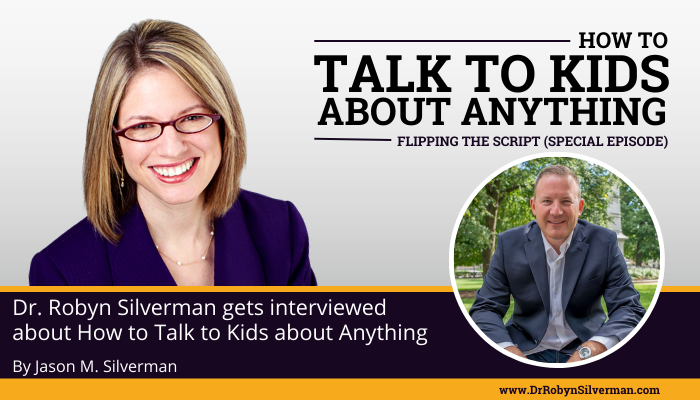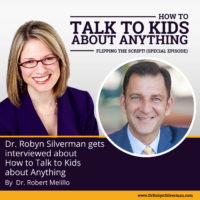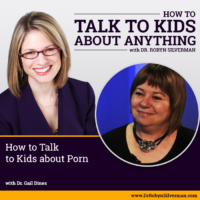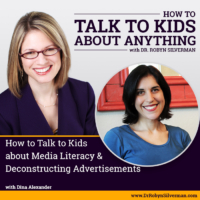Podcast: Play in new window | Download
Subscribe: Apple Podcasts | RSS | More
Flipping the Script! Dr. Robyn Silverman gets interviewed about How to Talk to Kids about Anything

Let us switch places and interview the heart and mind of this very own parenting and child development podcast, Dr. Robyn Silverman. Her throne will be replaced by her husband, the founder, Chief Executive Officer, and president of Silverman Consulting and Systems Success Mastermind, Mr. Jason Silverman.
Join us as we unravel the profound motivations that propelled the esteemed author, Dr. Robyn, in crafting her forthcoming book, How to Talk to Kids about Anything. We will now unveil the stories behind the words, the experiences that shaped the narrative, and the aspirations that breathe life into every tips and scripts.
Guest Expert: Dr. Robyn Silverman
We have a lot of TOUGH talks on this podcast. We’ve talked about sex, porn, suicide, bullying, neurodiversity, failure, death and so much more. It was always my aim to present you with the entire child development pie and invite amazing guests on the show, bestselling authors and top experts, who could dig deep, providing you with the deep slices of that pie so that you can have these conversations with your children and teens—and that they will come to us when they need someone to talk to as well. One thing I know for sure is that if we want our kids to talk to us about anything, we have to be willing to talk to our kids about everything.
Today’s guest in the hot seat is ME! Ha! Since my book comes out today, October 10th, and I couldn’t be more excited to share it with all of you. You’ve been part of my village and my community since 2017—we have been through a lot—and talked about some very intimate things—I will ask now, as I’ve never asked before, would you please go to wherever you get your books—Amazon, Barnes and Noble, Books a Million, Target, your local Indy Book store and order How to Talk to Kids about Anything right now. It’s been 6 years of work—interviews, researching, this podcast which I have never charged for- writing and editing– and I know you will find it worth it and love it—and once you order it and receive the book, please give those 5 star reviews because that will get more people to know about it, buy it, use it, and make a difference with their kids. Would you do that now please? Thank you in advance!
And now for my amazing moderator for today, none other than, my husband, whose been through it all with me. So I hope the Dads will give a good listen to what he has to say, he’s been through it all with me. The good, the bad, the ugly and the utterly hilarious. Jason Silverman and I have been married for almost 25 years- he’s a brilliant marketer, the founder, Chief Executive Officer and president of Silverman Consulting and Systems Success Mastermind, he’s a business development coach, my partner in Powerful Words Character System, and my partner in life—so welcome to the How to Talk to Kids about Anything podcast, and now, I’ll flip to guest mode!
Bio:
Dr. Robyn Silverman is a Child & Teen Development Specialist with a passion for helping kids develop their strengths and thrive. She has always seen children as assets to be developed rather than deficits to be managed. Known as “The Conversation Doc,” Dr. Robyn is the author of the forthcoming book, How to Talk to Kids about Anything, (and host of the popular podcast of the same name) which provides parents with scripts and tips to broach the toughest topics with children. She has been writing the worldwide program, Powerful Words Character System, for almost 25 years which gives educators the talking points they need to help children become kind, responsible citizens of the world. Dr. Robyn has appeared on the Today Show, Good Morning America, CBS Early Show and Nightline and has been quoted in the New York Times, Washington Post, CNN and many other publications. She lives with her husband, two kids and fuzzy dog in North Carolina.
Important messages:
- Know more about Dr. Robyn: In case you don’t know who Dr. Robyn Silverman is, she’s a child team development specialist with a passion for helping kids develop their strengths and helping them to thrive. She’s always seen children as assets to be developed rather than deficits to be managed.
- Creating this masterpiece: This book has been almost 40 years in the making. The book really started when I was in fifth grade because I was bullied during that year. I was completely by myself and I know that the aides were just standing there watching. I don’t know if they didn’t know what to say or they didn’t think it was their place to say anything, but they definitely didn’t do anything to change anything. Inside that building was no different during that time the teachers certainly saw what was going on. One of my teachers did call a meeting about it, but when she did, she ostracized me too.
- My mom didn’t know what to do. She just handed me tissue after tissue. I would cry and cry and cry and I just didn’t know how to change anything for me.
- Inspiration and Purpose: It is one of those times when your traumas really become the impetus for what you do in life, your purpose. When you go through that, it drives your purpose. And that’s what it did for me. I had to come up with what to say and what to do when people were in a position of not knowing what to say or do. They wanted to help, but they didn’t know what to do. I want to open up those conversations so that kids don’t feel so alone, so that they’re making the choice for themselves, that they’re worth it, and that they deserve the help, and that they can be enveloped with the support they need to make choices in life that will help them thrive.
- Concept of the Book: I wanted to write a book that I wanted to read, and so I write in the way that I want to consume information. I want to be able to open up a chapter, skim it through if I need to. I want to be able to see bullet points. I want to see charts. I want things to be really easy to take in at a moment’s notice. So if my child asks me a question, I want to be able to like, Hey, sweet pea, like, I really want to answer this question for you. This is really important. I’m so glad you came to me. I just need five minutes to just get my thoughts together. Let’s meet downstairs for ice cream, and then just be able to open it up and consume it right there on the spot.
- It’s not helpful to just know about the theory. I want the information that’s going to help me deliver what these kids need to know, when they need to know it.
- Accessible Information: I’m not just a child development specialist. I’m a parent. I need this information in easy chunks. We’re busy and we still want to have these conversations, but we don’t have hours to just sit and read and, and we may need to read something or skim something in two minutes. And other times that we may be able to sit down and, and read for a longer period of time. But a lot of times if you’ve read the chapters through sometimes you may just need to pick it up for that moment. And I wanted it to be that kind of buck.
- Common Mistakes of Parents: I think one of the ways that we may be doing it wrong, is by lecturing and by pushing your own agenda and our kids may have a different opinion about something important.
- Gauging the Type of Conversation: Are these conversation openers or are they conversation closers? “You don’t need to think that way, or you’re too young to think that way, or you’re too, you’re too young to even be considering this.” that’s going to close the door. It doesn’t make them not want to have the information; it just makes them get it from somewhere else.
- We’re not planting that seed. This is not actually how it works. The studies that they’ve done over and over again. Now, whether it’s on sex or porn or suicide or bullying, a million things, the studies continually say the same thing.
- Number one: Kids want to have these conversations with their parents.
- Number two: When we have these conversations with kids, they are less likely to engage in risky behavior.
- Number three: When we don’t have the conversations with these kids, they are more likely to engage in this risky behavior, and they’re more likely to go to somebody else to get the information. And you may not like what those people say.
- If I don’t talk to them about it, they’re going to delay all of that. That’s not how it works. They’re still kids in this world. They still want the information and if you’re not going to talk to them about it, somebody else will.
- Being your Child’s Safe Place: I want you to know that you will never, ever get in trouble for coming to us to let us know that something happened that made you feel uncomfortable or that you have questions about. You will never get in trouble for that, and you would never get in trouble for what you just told us.
- Talking about Sex: It’s awkward, but it’s so worth it. You got to have these conversations so that your kid has this information and that they know they can come to you and they know they can make informed decisions.
- If we want our children to talk to us about anything, we have to be willing to talk to them about everything.
- Being a Parent: You don’t need to know all the answers. You have to be a good listener. You have to ask good questions. You have to not push the agenda so much and really be open to hearing what your child has to say. And maybe your perspective will change along with it. I think there’s certainly times that we’ve found that our kids and the way that they approach topics and think about topics is different than the way we did, but we thought, oh, I hadn’t thought about it that way, and it changed our perspective, so that’s great.
- Talking about Diversity: I was afraid to write it because I felt like, who am I to write this? I’m a white woman, cisgender, and straight. I’m just not what people would think of. What makes me like fall into a diverse category?
- Making a Legacy: My hope is that this book is an evergreen book that people read. They revisit, they dog ear, they underline, they star, they highlight, and that it’s part of each school, each household, each gym, and afterschool program. My hope is that people will continue to read and reread and use this book to keep connecting with children. Understanding that if you’ve talked to them about a topic at age six, you’re not done. You’re going to keep going and, and keep revisiting these topics. Following up and making sure that these kids know that they can always come to you.
- Ultimate Advice for Parents: There are do-overs. So if you said it wrong or you wish you said it differently, or you wish you said something at all, you can go back and say, you remember when you asked me this or you brought this up or this happened, can we have that conversation now?
- Ultimate Advice for Coaches and Instructors who are truly ready to step up: You are one of the key people. There’s a child out there that may be coming to you, that’s coming to nobody else.
- One Team: So for those parents, for those teachers, for those educators, for those coaches, we’re all part of the same team. We all want these kids to thrive. We all want these kids to have the information so that they can answer questions for themselves. They can make good choices in the moment, and we want them to all feel supported and not so alone.
Notable quotable:
- “It is one of those times when your traumas really become the impetus for what you do in life, your purpose. When you go through that, it drives your purpose.”
- “I was driven to write this book so that other kids whether it was bullying or some other topic, knew what to do or say. And the teachers and the parents, they knew what to do or say. They could make it better.”
- “I want to open up those conversations so that kids don’t feel so alone, so that they’re making the choice for themselves, that they’re worth it, and that they deserve the help, and that they can be enveloped with the support they need to make choices in life that will help them thrive.”
- “I wanted to write a book that I wanted to read, and so I write in the way that I want to consume information. I want to be able to open up a chapter, skim it through if I need to. I want to be able to see bullet points. I want to see charts. I want things to be really easy to take in at a moment’s notice.”
- “It’s not helpful to just know about the theory. I want the information that’s going to help me deliver what these kids need to know, when they need to know it.”
- “I’m not just a child development specialist. I’m a parent. I need this information in easy chunks.”
- “They need to know whether we’re there or not.”
- “We’re busy and we still want to have these conversations, but we don’t have hours to just sit and read and, and we may need to read something or skim something in two minutes”
- “It doesn’t make them not want to have the information; it just makes them get it from somewhere else.”
- “They still want the information and if you’re not going to talk to them about it, somebody else will.”
- It’s awkward, but it’s so worth it. You got to have these conversations so that your kid has this information and that they know they can come to you and they know they can make informed decisions.”
- “If we want our children to talk to us about anything, we have to be willing to talk to them about everything.”
- “You don’t need to know all the answers. You have to be a good listener. You have to ask good questions. You have to not push the agenda so much and really be open to hearing what your child has to say. And maybe your perspective will change along with it”
- “Understanding that if you’ve talked to them about a topic at age six, you’re not done. You’re going to keep going and, and keep revisiting these topics. Following up and making sure that these kids know that they can always come to you.”
- “You can have a do-over because each day that you’re parenting is a new opportunity to try again.”
Resources:
- Facebook: https://www.facebook.com/DrRobynSilverman
- Instagram: https://www.instagram.com/drrobynsilverman/
- Twitter: https://twitter.com/DrRobyn
- Website: https://parenting.drrobynsilverman.com/
You can purchase the book here:
- Bookshop: https://bookshop.org/p/books/how-to-talk-to-kids-about-anything-tips-scripts-stories-and-steps-to-make-even-the-toughest-conversations-easier/18912584?ean=9781728246987
- Amazon: https://www.amazon.com/Talk-Kids-about-Anything-Conversations/dp/1728246989/ref=sr_1_1?crid=2DTRZ13WDMAA0&keywords=how+to+talk+to+kids+about+anything&qid=1696950664&sprefix=how+to+talk+to+kids+abuot%2Caps%2C100&sr=8-1
- Barnes&Noble: https://www.barnesandnoble.com/w/how-to-talk-to-kids-about-anything-robyn-silverman/1142463581?ean=9781728246987
- Books-a-Million: https://www.booksamillion.com/search?filter=&id=8969509417572&query=How+to+Talk+to+Kids+about+Anything








